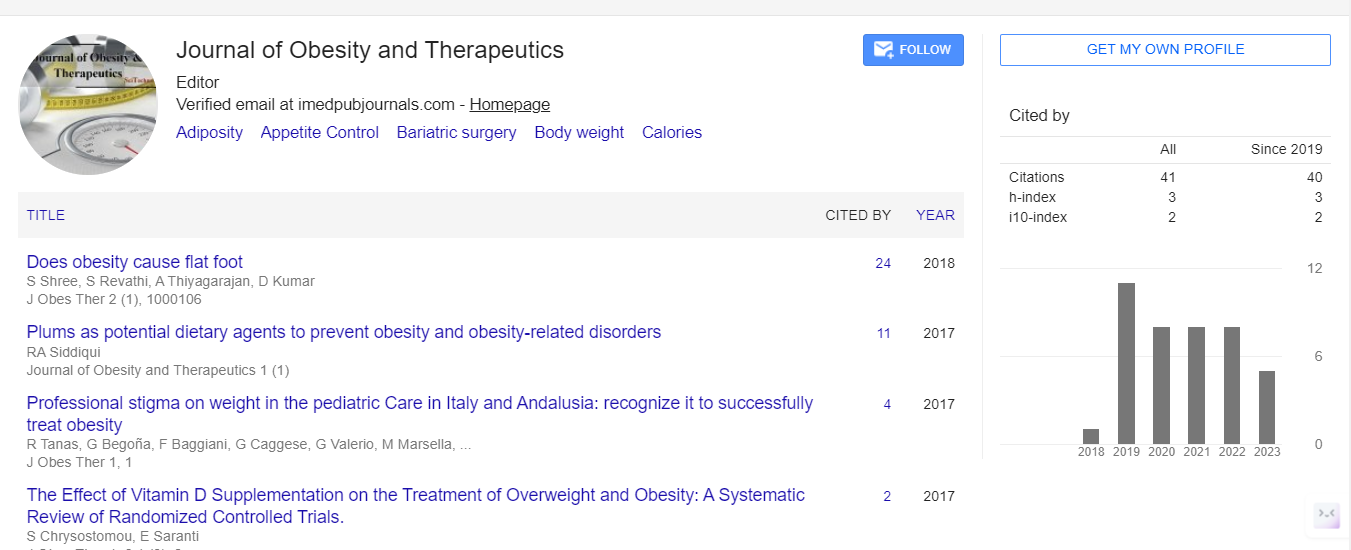Short Communication, J Obes Ther Vol: 8 Issue: 1
Infecto-Obesity in the Global Context: Epidemiological Patterns and Public Health Implications
Malaika Menezes*
1Department of Collective Health, Federal University of Rio Grande Do Norte, Natal, RioGrande do Norte, Brazil
*Corresponding Author: Malaika Menezes,
Department of Collective Health,
Federal University of Rio Grande Do Norte, Natal, RioGrande do Norte, Brazil
E-mail: menezesnorte2@gmail.com
Received date: 04 March, 2024; Manuscript No. Jot-24-135842;
Editor assigned date: 06 March, 2024; Pre QC No. Jot-24-135842 (PQ);
Reviewed date: 21 March, 2024, QC No. Jot-24-135842;
Revised date: 28 March, 2024, Manuscript No: Jot-24-135842 (R);
Published date: 05 April, 2024, DOI:10.4172/jot.1000252.
Citation: Menezes M (2024) Infecto-Obesity in the Global Context: Epidemiological Patterns and Public Health Implications. J Obes Ther 8:1.
Description
The convergence of infectious diseases and obesity has given rise to the concept of "infecto-obesity," an intricate interplay between infectious agents and the development of obesity. This review delves into the epidemiological patterns of infecto-obesity at a global scale and elucidates the far-reaching public health implications associated with this complex phenomenon.
Infecto-obesity encompasses a wide spectrum of epidemiological patterns that vary across different regions, populations, and age groups. The prevalence of infecto-obesity reflects the intricate dynamics between infectious outbreaks and the predisposition to obesity, shedding light on the multifaceted nature of this emerging public health challenge [1,2].
Epidemiological studies reveal significant global disparities in the distribution of infecto-obesity, with distinct patterns emerging in both developed and developing countries. While certain regions grapple with the burden of specific infectious diseases contributing to obesity, others experience contrasting trends, offering valuable insights into the diverse epidemiological landscape [3,4].
The epidemiology of infecto-obesity exhibits complex agedependent patterns, with distinct trends observed in pediatric populations, adolescents, and adults. Understanding the age-specific epidemiology of infecto-obesity is crucial for tailoring targeted interventions and public health strategies to address this multifaceted challenge [5,6]
The emergence of infecto-obesity carries profound public health implications, necessitating a paradigm shift in the approach to disease prevention, health promotion, and healthcare delivery. By scrutinizing the public health implications of infecto-obesity, we gain critical insights into the holistic impact on population health and well-being, paving the way for evidence-based policy formulations and interventional strategies.
Infecto-obesity poses a considerable strain on healthcare systems globally, requiring enhanced resilience, resource allocation, and a reorientation of health services to effectively address the complex interplay between infectious diseases and obesity. The evolving epidemiological patterns of infecto-obesity demand a proactive response to ensure the optimal allocation of resources for disease surveillance, prevention, and management [7].
The multifactorial etiology of infecto-obesity mandates an integrated approach to disease management, encompassing infectious disease control, nutritional interventions, and obesity prevention strategies. Public health initiatives aimed at addressing infecto-obesity must adopt a coordinated and multidisciplinary framework to effectively contend with the multifaceted challenges it presents [8].
Incorporating the epidemiological patterns of infecto-obesity into targeted intervention strategies is paramount for curtailing the burden of this complex public health issue. Tailored public health initiatives, including vaccination programs, nutritional counseling, and community-based obesity prevention efforts, are essential components of a comprehensive approach to addressing infecto-obesity at a population level [9].
The epidemiological patterns of infecto-obesity in the global context underscore the intricate interplay between infectious diseases and obesity and shed light on the multifaceted nature of this burgeoning public health challenge. By recognizing the nuanced epidemiological patterns and delineating the far-reaching public health implications associated with infecto-obesity, there is potential to develop evidence-based policy frameworks, targeted interventions, and integrated management strategies to address this complex and evolving public health issue [10].
References
- Huttunen R, Syrjanen J (2013) Obesity and the risk and outcome of infection. Int J Obes (Lond) 37:333–40.
- Fezeu L, Julia C, Henegar A, Bitu J, Hu FB, et al (2011) Obesity is associated with higher risk of intensive care unit admission and death in influenza A (H1N1) patients: a systematic review and meta-analysis. Obes Rev 12:653–9.
[Google Scholar] [PubMed]
- Van Kerkhove MD, Vandemaele KA, Shinde V, Jaramillo-Gutierrez G, Koukounari A, et al (2011) Risk factors for severe outcomes following 2009 influenza A (H1N1) infection: a global pooled analysis. PLoS Med 8:e1001053.
[Google Scholar] [PubMed]
- Bochicchio GV, Joshi M, Bochicchio K, Nehman S, Tracy JK, et al (2006) Impact of obesity in the critically ill trauma patient: a prospective study. J Am Coll Surg 203:533–8.
[Google Scholar] [PubMed]
- Wurzinger B, Dunser MW, Wohlmuth C, Deutinger MC, Ulmer H, et al (2010) The association between body-mass index and patient outcome in septic shock: a retrospective cohort study. Wien Klin Wochenschr 122:31–6.
[Google Scholar] [PubMed]
- Basu JK, Jeketera CM, Basu D (2010) Obesity and its outcomes among pregnant South African women. Int J Gynaecol Obstet 110:101–4.
[Google Scholar] [PubMed]
- Olsen MA, Higham-Kessler J, Yokoe DS, Butler AM, Vostok J, et al (2009) Developing a risk stratification model for surgical site infection after abdominal hysterectomy. Infect Control Hosp Epidemiol 30:1077–83.
[Crossref] [Google Scholar] [PubMed]
- Waisbren E, Rosen H, Bader AM, Lipsitz SR, Rogers SO Jr, et al (2010) Percent body fat and prediction of surgical site infection. J Am Coll Surg 210:381–9.
[Crossref] [Google Scholar] [PubMed]
- Towfigh S, Chen F, Katkhouda N, Kelso R, Sohn H, et al (2008) Obesity should not influence the management of appendicitis. Surg Endosc 22:2601–5.
[Google Scholar] [PubMed]
- Martinez J, Johnson CD, Sanchez-Paya J, de Madaria E, Robles-Diaz G, et al (2006) Obesity is a definitive risk factor of severity and mortality in acute pancreatitis: an updated meta-analysis. Pancreatology 6:206–9.
[Google Scholar] [PubMed]
 Spanish
Spanish  Chinese
Chinese  Russian
Russian  German
German  French
French  Japanese
Japanese  Portuguese
Portuguese  Hindi
Hindi 